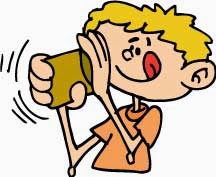 In 1964 John Holt wrote a book entitled "How Children Fail." About five years later, Dr. William Glasser wrote "Schools Without Failure." These books promoted the idea that students should be given the opportunity to succeed, that grades often got in the way of that success, and that some students got so used to failure they would simply give up rather than work hard to get a passing grade.
In 1964 John Holt wrote a book entitled "How Children Fail." About five years later, Dr. William Glasser wrote "Schools Without Failure." These books promoted the idea that students should be given the opportunity to succeed, that grades often got in the way of that success, and that some students got so used to failure they would simply give up rather than work hard to get a passing grade.To get those children back on the path to success, we were encouraged to eliminate grades and emphasize that all students could be successful in school. These are all very well written books and have some excellent suggestions for improving school environments for children.
Unfortunately, some people took that idea to the extreme. Sports banquets no longer recognized the best and brightest athletes. Rather, all teammates received an award. Games were no longer about winning and losing but working as a team. Our competitive spirit was suppressed to the point of eliminating any winners or losers.
Here's an interesting article about the benefits of failure in the business world: Why We Should All Embrace the F-Word (Failure)
All too often, the word “failure” carries with it the threat of a career-ending catastrophe, so much so that uplifting euphemisms such as “opportunity” are thrown about in its wake. And in the classroom the word "failure" becomes taboo.
We want our students to have lots of opportunities to be successful. But we also want them to learn to pick themselves up and keep going when they fail. Perseverance and resilience are character traits we would like to instill in each student who enters our classroom. Many of the inventions we have today were the result of initial failures. The Post-It Note is a perfect example (so are potato chips and corn flakes—read more from MIT). When students are able to keep going after a setback or failure, they learn life lessons that prepare them for the future while helping them mature today.
 You don't have to be a tough teacher to see results with Excel Math. Our proven lessons teach students foundational math concepts. The unique spiraling system helps children build confidence in their math skills and retain the concepts they learn for the long term. Excel Math can even help students develop a love for math!
You don't have to be a tough teacher to see results with Excel Math. Our proven lessons teach students foundational math concepts. The unique spiraling system helps children build confidence in their math skills and retain the concepts they learn for the long term. Excel Math can even help students develop a love for math!
For over 35 years, these math lessons have been proven to develop higher-order thinking skills, build proficiency, and produce confidence in students of all ages and abilities. Excel Math was written to give teachers the tools they need to help students develop a strong foundation in math. Read more about Excel Math and its systematic spiraling process at excelmath.com.
New to Excel Math? Preview elementary math lessons that really work for Kindergarten through Sixth Grade on our website: www.excelmath.com.
Do you consider yourself to be a tough teacher? Leave a comment by clicking on the word "comments" below.
Read more . . .
This story from the Wall Street Journal explains first-hand how a tough music teacher who allowed his students to fail earned the respect of those students, many of whom went on to become successful in music as well as in many unrelated fields: Why Tough Teachers Get Results.
 You don't have to be a tough teacher to see results with Excel Math. Our proven lessons teach students foundational math concepts. The unique spiraling system helps children build confidence in their math skills and retain the concepts they learn for the long term. Excel Math can even help students develop a love for math!
You don't have to be a tough teacher to see results with Excel Math. Our proven lessons teach students foundational math concepts. The unique spiraling system helps children build confidence in their math skills and retain the concepts they learn for the long term. Excel Math can even help students develop a love for math!For over 35 years, these math lessons have been proven to develop higher-order thinking skills, build proficiency, and produce confidence in students of all ages and abilities. Excel Math was written to give teachers the tools they need to help students develop a strong foundation in math. Read more about Excel Math and its systematic spiraling process at excelmath.com.
New to Excel Math? Preview elementary math lessons that really work for Kindergarten through Sixth Grade on our website: www.excelmath.com.
Download sample lessons from our new Common Core Teacher Editions at http://excelmath.com/downloads/state_stds.html
Do you consider yourself to be a tough teacher? Leave a comment by clicking on the word "comments" below.
Read more . . .
You might also like these articles:












